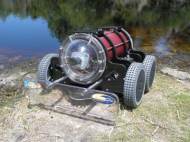Hull Bio-mimetic Underwater Grooming (Hull BUG)
 As researchers around the world work to uncover new materials to combat marine biofouling, the US Office of Naval Research (ONR) is supporting the development of novel approaches that are proving to be effective at biofouling prevention. In fact, the Naval Surface Warfare Center at Carderock (NSWCCD) estimates that biofouling reduces vessel speed by up to 10 percent. Vessels can require as much as a 40 percent increase in fuel consumption to counter the added drag. Hence, development of an underwater grooming device started. Called the robotic Hull Bio-mimetic Underwater Grooming (Hull BUG) is designed to groom and maintain ship or yacht hull surfaces.
As researchers around the world work to uncover new materials to combat marine biofouling, the US Office of Naval Research (ONR) is supporting the development of novel approaches that are proving to be effective at biofouling prevention. In fact, the Naval Surface Warfare Center at Carderock (NSWCCD) estimates that biofouling reduces vessel speed by up to 10 percent. Vessels can require as much as a 40 percent increase in fuel consumption to counter the added drag. Hence, development of an underwater grooming device started. Called the robotic Hull Bio-mimetic Underwater Grooming (Hull BUG) is designed to groom and maintain ship or yacht hull surfaces.
It incorporates the use of a biofilm detector that utilizes modified fluorometer technology to enable the robot to detect the difference between the clean and unclean surfaces on the hull of a ship. Although it looks simple, a significant amount of innovation goes into its operation. In particular, the robot incorporates the use of a biofilm detector that utilizes modified fluorometer technology to enable the robot to detect the difference between the clean and unclean surfaces on the hull of a ship. Used to groom ships in port, the Hull BUG removes the marine biofilm and other marine organisms before they get solidly attached. This is especially important because most ships spend more than 50 percent of their life in port, giving barnacles and marine life ample time to become settled and, if allowed, to further colonize and grow on the ship’s hull.
According to Bill Hertel, a mechanical engineer at NSWCCD, “Hull BUG is a complex project in the sense that it has to encompass many different areas of expertise. The ONR team is out to develop capabilities that do not currently exist to achieve realistic benefits that haven’t yet been realized.”
Geoff Swain, professor of Oceanography and Ocean Engineering at the Florida Institute of Technology, oversees ONR’s Hull BUG testing and was impressed with the test results. “The Hull BUG autonomously groomed and removed biofilm from an area on the port midship section of the hull in a preprogrammed pattern,” notes Swain.
Like other ONR projects, Hull BUG benefits will extend beyond the Navy. “Basically any boat over 45 feet (15m), which is in the water all the time, can benefit from this kind of technology,” says Don Darling, President of SeaRobotics.
Ken Holappa, a SeaRobotics engineer agrees. “Just like the Navy, the savings to the commercial shipping industry stand to be significant in terms of fuel efficiency and in reducing emissions associated with ship operations in our world’s oceans.”
This technology is, if nothing else, a good starting solution to lessen energy consumption of naval vehicles. If the figures are correct and there’s no more elegant solution, we could expect some more commercially available robots to appear pretty soon.









Leave your response!